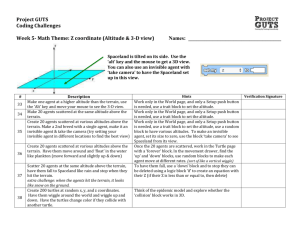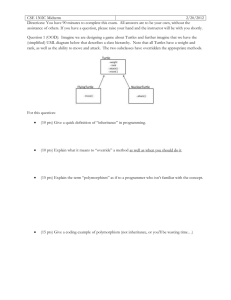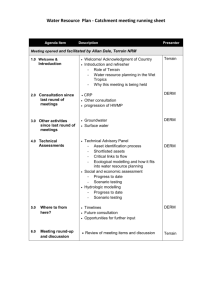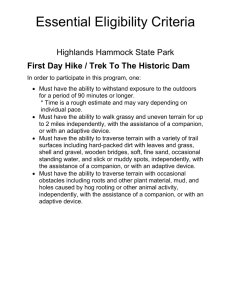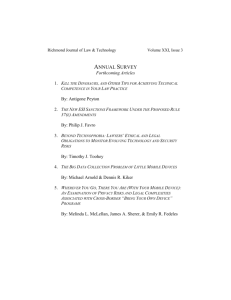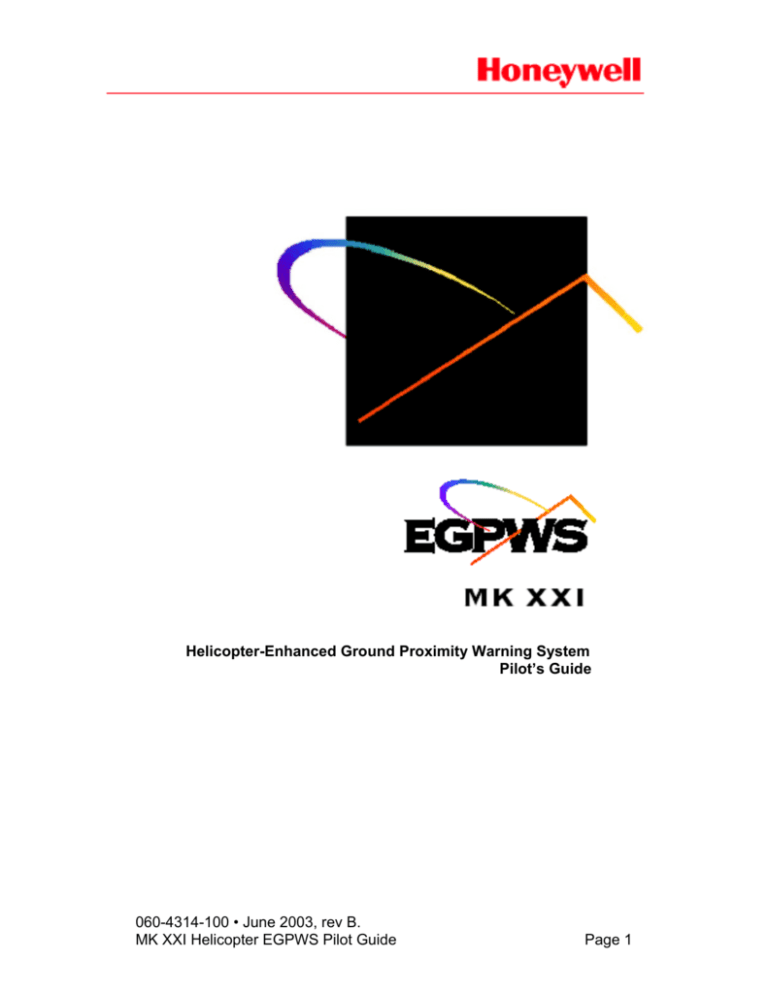
Helicopter-Enhanced Ground Proximity Warning System
Pilot’s Guide
060-4314-100 • June 2003, rev B.
MK XXI Helicopter EGPWS Pilot Guide
Page 1
Copyright 2003
Honeywell International Inc.
All rights reserved
This document and all information and expression contained
herein are the property of Honeywell International Inc., and is
provided to the recipient in confidence.
Use of this document is strictly limited to a legitimate business
purpose requiring the information contained therein. Your use of
this document constitutes acceptance of these terms.
060-4314-100 • June 2003, rev B.
MK XXI Helicopter EGPWS Pilot Guide
Page 2
TABLE OF CONTENTS
1
INTRODUCTION..............................................................................................................................................5
2
WHAT IS THE HELICOPTER EGPWS? ......................................................................................................6
3
MK XXI HELICOPTER EGPWS....................................................................................................................7
4
PHYSICAL DESCRIPTION ............................................................................................................................7
5
MK XXI FUNCTIONS AND FEATURES ......................................................................................................8
5.1
5.2
5.3
5.4
AIRCRAFT POSITION .........................................................................................................................................8
AIRCRAFT ALTITUDE .......................................................................................................................................9
SIGNAL QUALITY .............................................................................................................................................9
SOFTWARE AND DATABASE LOADING .............................................................................................................9
6
TERRAIN, OBSTACLES & RUNWAY DATABASE .................................................................................10
7
COCKPIT SWITCHES...................................................................................................................................11
7.1
7.2
8
TERRAIN AWARENESS DISPLAY.............................................................................................................12
8.1
8.2
8.3
8.4
8.5
8.6
8.7
8.8
8.9
9
TERRAIN INHIBIT SWITCH ..............................................................................................................................11
LOW ALTITUDE SWITCH.................................................................................................................................11
AUTO RANGE .................................................................................................................................................12
POPUP MODE..................................................................................................................................................12
DISPLAY COLORS ...........................................................................................................................................12
PEAKS MODE OPERATION ..............................................................................................................................14
COLOR INDICATION ........................................................................................................................................14
DISPLAY EXAMPLES .......................................................................................................................................15
CELL EXPANSION ...........................................................................................................................................16
LOOK- AHEAD” ALERTING AND WARNING ....................................................................................................16
TERRAIN FAILURE ..........................................................................................................................................17
NORMAL PROCEDURES .............................................................................................................................18
9.1 MK XXI SYSTEM SELF-TEST ........................................................................................................................18
9.2 “WARNING TERRAIN” OR “WARNING OBSTACLE” ........................................................................................19
9.2.1
Instrument Conditions..........................................................................................................................19
9.2.2
Visual conditions .................................................................................................................................19
9.3 RECOMMENDED PROCEDURES FOR MK XXI ALERTS IN FLIGHT ..................................................................20
10
MK XXI ADDITIONAL INFORMATION ...................................................................................................20
10.1
AUDIO MESSAGE PRIORITY.......................................................................................................................20
11
MK XXI LAMPS & SWITCHES ...................................................................................................................21
12
MK XXI SYSTEM LIMITATIONS / CONSTRAINTS...............................................................................21
13
MK XXI SOFTWARE UPDATE PROCEDURES .......................................................................................22
14
APPLICATION SOFTWARE & TERRAIN DATABASE VERSION VERIFICATION........................22
15
MK XXI DATABASE UPDATE PROCEDURE ..........................................................................................23
16
MK XXI TECHNICAL SPECIFICATIONS.................................................................................................24
17
MK XXI PRODUCT SUPPORT ....................................................................................................................24
060-4314-100 • June 2003, rev B.
MK XXI Helicopter EGPWS Pilot Guide
Page 3
This Page Intentionally
Left Blank
060-4314-100 • June 2003, rev B.
MK XXI Helicopter EGPWS Pilot Guide
Page 4
1 Introduction
The MK XXI Helicopter Enhanced Ground Proximity Warning System brings
state-of-the-art technology in Terrain Display, Situational Awareness, Terrain and
Obstacle Warning and Advisory Callouts to the Rotorcraft Pilot. The MK XXI is a
lightweight, compact and rugged computer that is easily installed in modern
helicopters.
Based on 30 years experience in the development and advancement of Ground
Proximity Warning Systems for Air Transport, Regional and Commuter Airlines,
Military aircraft and Corporate Aviation, Honeywell brings this vital safety
technology to all segments of helicopter operations. Using our proprietary worldwide terrain database, obstacle database, runway database, state-of-the-art GPS
technology, and proven Terrain Display with Alerting and Warning functions, the
MK XXI provides the Helicopter Pilot with superior Situational Awareness with
respect to terrain and known obstacles. In addition, the MK XXI contains the
most advanced alerting and warning functionality to warn the pilot of danger with
respect to terrain, man-made obstacles and other primary scenarios associated
with the dangers of Controlled Flight Into Terrain (CFIT).
This Pilot’s Guide outlines the basic requirements for system operation and
recommended procedures for use of the MK XXI by the Helicopter Pilot.
This Guide does NOT supersede FAA Approved Data or FAA Flight Manual
Supplements, or FAA Required Procedures. Each pilot should be thoroughly
familiar with his or her aircraft, its systems, and FAA and/or company
requirements for that aircraft as equipped with the MK XXI Helicopter Enhanced
Ground Proximity Warning System.
MK XXI Computer
060-4314-100 • June 2003, rev B.
MK XXI Helicopter EGPWS Pilot Guide
Page 5
2 What is the Helicopter EGPWS?
The Honeywell MK XXI is a small lightweight computer that can be installed in
light and medium sized helicopters.
The MK XXI computer is compact and rugged, and can be mounted in any
orientation to meet the requirements of the aircraft and space limitations. The
MK XXI uses information from an existing GPS (already in the aircraft) or internal
GPS receiver contained in the MK XXI computer, pressure altitude and other
optional inputs and generates visual & aural warning and a relative position to
terrain situational display.
The MK XXI receives inputs from several sources on the aircraft. They may
include the following:
•
•
•
•
•
•
•
GPS Altitude, Position, Ground Speed & Track
GPS Signal Quality Display Range
Pressure Altitude
Vertical Speed (optional)
Magnetic Heading (optional)
Roll (optional)
OAT (optional)
These may differ depending on aircraft and installation.
The terrain database, obstacle database and alerting / warning functionality are
contained in the MK XXI computer.
Outputs generated by the MK XXI are:
• Terrain / Obstacle Display
• Voice Alerts / Warnings
• Visual Cautions / Warnings
Please note that the normal operation of the MK XXI Helicopter EGPWS
allows alerting to 60 or 70 kts (configurable) ground speed only. Since
Helicopters land anywhere in their normal operation the EGPWS will
provide CFIT protection alerting down to either 60 or 70 kts ground speed.
As the helicopter approaches a landing site at greater than the configured
60 or 70 kts ground speed, EGPWS alerting will continue until the ground
speed decreases below the configured value.
060-4314-100 • June 2003, rev B.
MK XXI Helicopter EGPWS Pilot Guide
Page 6
3 MK XXI Helicopter EGPWS
During normal flight operations, the MK XXI remains essentially silent. Using
GPS, altitude, magnetic heading and temperature (optional) data in combination
with it’s various database information the MK XXI provides the pilot with a display
of the aircraft position relative to surrounding terrain and known obstacles,
thereby providing unprecedented situational awareness for the pilot. Pilot
workload in interacting with the system during normal flight is minimal.
Should the aircraft fly into danger where a conflict with terrain or a known
obstacle is imminent, the MK XXI will provide a combination of annunciator lights,
color display and aural alerts to the pilot.
Pilot reactions to cautions and warnings differ according to weather conditions,
visibility, and type of warning, phase of flight and aircraft performance
considerations. Pilots should be thoroughly familiar with FAA, company, or other
approved operational procedures as required by their aircraft and type of
operation.
Pilots should train to react properly to MK XXI cautions and warnings just as one
would train to react to any engine failure or any other emergency situation.
4 Physical Description
MK XXI EGPWS
Weight = 1.5 Lbs. Max
060-4314-100 • June 2003, rev B.
MK XXI Helicopter EGPWS Pilot Guide
Page 7
5 MK XXI Functions and Features
5.1
Aircraft Position
The MK XXI always knows where it is relative to the ground. It continually
compares its GPS position to the terrain database.
The MK XXI uses the Global Positioning System (GPS) information from either
an aircraft-installed GPS receiver, or an internal GPS receiver contained in the
MK XXI computer itself. It is necessary for the pilot to be aware of the actual
position source being used by the EGPWS, as the optional internal GPS is not
used for navigation of the aircraft. GPS signals arrive at an antenna on the
aircraft and are then processed by the MK XXI computer to provide both
horizontal (lateral) and vertical position (altitude) information. This position
in space is then compared to the terrain and obstacle database information
contained in the MK XXI computer to produce a “virtual” picture which can then
be displayed to provide Situational Awareness for the pilot.
Information from GPS and other aircraft systems are used by the MK XXI to
calculate track, ground speed, vertical velocity and signal accuracy. This
provides a complete picture of not only the aircraft position in three dimensions,
but also an excellent picture of the aircraft’s flight path and the health of the
Enhanced Ground Proximity Warning System.
When the GPS view of the satellites is momentarily obstructed by terrain
shadowing or when in a turn, the EGPWS will go into a dead reckoning mode for
up to 20 seconds. If the satellite shadowing lasts longer than 20 seconds the
“Terrain INOP” light will be illuminated and the “Be Alert Terrain INOP” voice
message given.
This total package of information is used to provide Terrain Displays for the
pilots, and to provide alerting and warning functionality which protects the pilot
and passengers from possible conflicts with terrain, known obstacles, and other
scenarios associated with the dangers of Controlled Flight Into Terrain (CFIT).
060-4314-100 • June 2003, rev B.
MK XXI Helicopter EGPWS Pilot Guide
Page 8
5.2
Aircraft Altitude
The MK XXI uses barometric pressure, and a special GPS “derived-altitude”
developed by Honeywell called “Geometric Altitude”. It provides more
accurate altitude information, which is using the same Mean Sea Level (MSL)
reference as the terrain, obstacle and runway/helipad databases in the system.
The blending functionality of “Geometric Altitude” means it is much less
susceptible to errors induced by the pilot, cold temperature or malfunctions in
altimeter systems. (The pilot is NOT required to enter an altimeter setting
specifically for the MK XXI system).
Where aircraft are routinely operated in extreme temperature conditions (either
hot or cold). The blending formula of “Geometric Altitude” provides an even more
accurate vertical position to the MK XXI. This prevents serious discrepancies
between actual altitude and “Geometric Altitude” under extreme temperature
conditions, especially during rapid climbing or descending flight profiles.
5.3
Signal Quality
The MK XXI computer continually monitors the information it receives for
reasonability and assigns these inputs a quality value. This value is used to
modify the caution and warning Look-Ahead envelope.
5.4
Software and Database Loading
Software and the Terrain and Obstacle Databases are loaded from a Compact
flash card. Separate cards are available for software and database updates. The
database card contains all the terrain data and known obstacles data (where
available) used by the MK XXI. Instructions for update procedures and
installation of the compact flash database card are discussed later in this guide.
060-4314-100 • June 2003, rev B.
MK XXI Helicopter EGPWS Pilot Guide
Page 9
6 Terrain, Obstacles & Runway Database
Terrain data is supplied from the same proprietary database used by other
Honeywell EGPWS products, and is divided into nine overlapping regions that
cover the world. (See picture below).
The terrain data is divided into grid patterns of various sizes, from areas about
600 feet square resolution to areas of about 0.5 NM square. This allows a large
area of data to be stored in the unit, and allows high-resolution for areas where
the more accurate where the data is available. For a current description of the
high-resolution Database coverage see the EGPWS website at
http://www.egpws.com.
Data for known obstacles such as towers, buildings, antennas, etc. are contained
on the same data card as the terrain and airport data. Presently, obstacles are
included for North America (NAM), parts of Europe (EUR) and parts of the South
Pacific (SPA) regions. As more reliable information becomes available,
Honeywell will expand the capability to provide alerting and warning for obstacles
in other areas of the world.
Obstacles in the database are those known man made obstructions more than
100 feet AGL, so obstacles of lower height will not produce MK XXI “Obstacle”
alerts. They may actually produce a “Terrain” alert. The Terrain and Obstacle
database information should be accurate to within 25 feet.
CAUTION: Wires are not presently included in the MK XXI database.
As data becomes available, Honeywell intends to add power lines to the
Obstacle Database. Operators with access to Power Line data or with unique
obstacles within their operational area should contact the Honeywell Database
department through the Internet web site at http://www.egpws.com.
060-4314-100 • June 2003, rev B.
MK XXI Helicopter EGPWS Pilot Guide
Page 10
Runway database information in the MK XXI computer contains all publicly
known runways at airports that have an instrument approach procedure (no
heliports are included). This data is used to adjust the alerting and warning
functions of the MK XXI so as to provide a dynamic system that is essentially free
of nuisance or unwanted warnings. A list of runways in the database can be
accessed at the Internet website: www.egpws.com. A list of the most recent
database versions available for the MK XXI can also be found there.
7 COCKPIT SWITCHES
7.1
Terrain Inhibit Switch
The MK XXI requires the installation of a “Terrain Inhibit” switch. When
engaged by the pilot, this switch will inhibit the Terrain and Obstacle alerts and
warnings, however the Terrain Display will remain operational. The purpose of
the “Terrain Inhibit” switch is to allow aircraft to operate in VFR conditions
in areas that are close to high terrain and or in metropolitan areas of high rise
buildings. The “Terrain Inhibit” switch should be NOT engaged for most
normal operations. If you find that you need to use this switch during your
normal operations please contact Honeywell at http://www.egpws.com or
customer support at (800) 712-0400.
7.2
Low Altitude Switch
To allow for helicopter operations that require low altitude flight a “Low Altitude”
function is enabled with a switch. This function is designed for flight at low
altitude or operations close to terrain or obstacles in VFR conditions. When this
function is engaged the Terrain Advisory look ahead distances are reduced.
Low Altitude operation is defined as operation below 500 feet AGL at cruise
speed. There are other circumstances where the use of the Low Altitude Mode is
appropriate. Those include operation in a high-density metropolitan environment
with high rise buildings. The “Low Altitude” or “Terrain Inhibit” selection
should not be selected during normal takeoff or approach procedures.
CAUTION: The pilot must maintain visual contact with all terrain and
obstacles at all times when using the Low Altitude mode. The Low Altitude
mode must not be engaged during IFR conditions. The “look down” angle
is reduced with “Low Altitude” engaged. Warning time is greatly reduced.
The only exception is some IFR Approach procedures to Offshore
Platforms.
060-4314-100 • June 2003, rev B.
MK XXI Helicopter EGPWS Pilot Guide
Page 11
8 Terrain Awareness Display
The MK XXI can be interfaced with Weather Radar, or Multifunction displays.
Graphical display of MK XXI terrain and obstacle data is the most important
enhancement to Situational Awareness.
This is especially true for helicopters. In addition to showing terrain ahead of the
aircraft, (depending on configuration settings and display types) the MK XXI
shows MSL altitude, range in NM, and the elevations of the highest and lowest
terrain features shown on the display. Normally, the top of the display is oriented
to true heading. When true heading is not available, the display will orient to true
track. The color and intensity of the terrain displayed instantly alerts the pilot to
areas of dangerous terrain and conversely to areas of less precipitous terrain.
(Refer to the MK XXI System Installation Manual for a list of supported displays).
Range of the Terrain Display is selectable by the pilot from 1.0 NM to 320 NM,
again depending upon the display type installed in the aircraft.
8.1
Auto Range
If an alert occurs and the range is not already set at 5 NM, the MK XXI will
automatically change the range to 5 NM. If the Low Altitude Mode is selected the
range will be set to 2.5 NM. This feature is referred to as “Auto Range” and is
not supported by all displays.
If the displays do not support “Auto Range”, the pilot should set the range to 2.5
NM when in the “Low Altitude Mode”. The auto range selection values are
configurable to 2.5nm, 5.0nm and 10nm.
8.2
Popup Mode
If the primary MK XXI display is being used for something else, i.e. radar, when
an alert is triggered the display will automatically “Popup” and switch to the MK
XXI Terrain display. This feature is referred to as “Auto Popup” and is not
supported by all displays.
If the displays do not support “Auto Popup”, the audio warnings and annunciator
lights will still function normally.
8.3
Display Colors
The MK XXI will adjust colors on the Terrain Display automatically as the aircraft
altitude changes. The Terrain Display also transitions between the lower altitude
“relative” display and the higher altitude “peaks” display automatically, so no pilot
action is required.
060-4314-100 • June 2003, rev B.
MK XXI Helicopter EGPWS Pilot Guide
Page 12
The figure below shows the Terrain Display color patterns when the aircraft is at
lower altitudes. These colors will vary slightly depending on the type of display.
The most important function of the MK XXI is to provide the pilot with easily
interpreted information about terrain/obstacles relative to the aircraft, and thus
increase the pilot’s Situational Awareness.
In brief, when using the Terrain Display during flight, the normal presentation of
green, yellow and red colors indicate:
GREEN colors
Terrain/Obstacles are below the aircraft altitude. Safe terrain/obstacle
clearance is indicated.
YELLOW colors
Terrain is very near or above the aircraft altitude.
THE AIRCRAFT MAY NOT HAVE SAFE TERRAIN CLEARANCE.
RED color
Terrain is well above the aircraft altitude (at least 500 feet higher!)
THE AIRCRAFT DOES NOT HAVE SAFE TERRAIN CLEARANCE.
THE AIRCRAFT MAY NOT BE ABLE TO ESCAPE THIS TERRAIN.
060-4314-100 • June 2003, rev B.
MK XXI Helicopter EGPWS Pilot Guide
Page 13
8.4
Peaks Mode Operation
Peaks mode operation is the automatic style transition of the terrain display when
the aircraft is more than 250 feet above all terrain in the display area. It is a
combination of up to three green shades that allows the pilot to see where terrain
features are, such as valleys and mountain tops, that are below the aircraft.
The chart below outlines all the various colors used by the MK XXI Terrain
Display and their function in providing Situational Awareness to the pilot. Some
display types may not support all colors listed, or may display colors in slightly
different densities than those listed. The MK XXI is designed to present the most
appropriate Terrain Display capable on the various display types usable by the
system.
8.5
Color Indication
Solid Red
Terrain/Obstacle Threat Area – Warning.
Solid Yellow
Terrain/Obstacle Threat Area – Caution.
50% Red Dots
Terrain/Obstacle that is more than 500 feet above aircraft altitude.
50% Yellow Dots
Terrain/Obstacle that is between aircraft altitude and 500 feet above.
25% Yellow Dots
Terrain/Obstacle that is between aircraft altitude and 250 feet below.
Shown only when no Red or Yellow Terrain/Obstacle areas are within range
on the display. Highest terrain/obstacle not within 250’ of aircraft altitude.
When aircraft is within 250’ then solid green is usually covered by yellow
over red.
Terrain/Obstacle that is 250 feet below to 500 below aircraft altitude.
(Peaks only) Terrain/Obstacle that is the middle elevation band when there
is no Red or Yellow terrain areas within range on the display.
Solid Green
50% Green Dots
16% Green Dots
Terrain/Obstacle that is 500 to 1500 feet below aircraft altitude.
(Peaks only) Terrain/Obstacle that is the lower elevation band when there is
no Red or Yellow terrain areas within range on the display.
Black
No significant Terrain/Obstacle.
16% Cyan
Area having sea level elevation (0 feet MSL).
Magenta Dots
Unknown terrain. No terrain data in the database for the magenta area
shown
060-4314-100 • June 2003, rev B.
MK XXI Helicopter EGPWS Pilot Guide
Page 14
8.6
Display Examples
The two displays below represent typical examples of mountainous terrain and
peaks mode.
MSL approaching a ridge 20 NM
South of Asheville, NC
Same as above at 3,000 feet MSL.
Note obstacles (towers) in red.
On some terrain displays, an indication of MSL or GSL (Geodetic Sea Level)
altitude will appear. This altitude is the reference altitude for the display and the
terrain awareness algorithm. This reference altitude is based on internally
calculated Geometric Altitude (see page 9) and NOT corrected barometric
altitude. It represents the aircraft’s calculated true height above sea level (MSL)
and serves as the reference altitude for color coding of the terrain display (see
above) and the altitude input to the look-ahead algorithm. Because it is primarily
comprised of GPS altitude, this reference altitude will often differ from cockpit
displayed corrected barometric altitude. This altitude is not to be used for
navigation. It is presented to provide the crew with additional situational
awareness of true height above sea level, upon which terrain alerting and display
is based.
060-4314-100 • June 2003, rev B.
MK XXI Helicopter EGPWS Pilot Guide
Page 15
8.7
Cell Expansion
When flying with the range set at greater than 10 NM it can be difficult using the
display to determine where a nearby threat may be relative to the aircraft. This is
due to the size of the threat vs. the amount of terrain displayed. To relieve this
problem the MK XXI will increase the size of the grids that contain an obstacle or
terrain threat. This feature is called “Cell Expansion”. Cell Expansion is not used
when the display range is less than or equal to 10 NM.
8.8
Look- Ahead” Alerting and Warning
Using aircraft position, altitude and flight path information, the MK XXI provides
an envelope of protection for the aircraft that is independent from the Terrain
Awareness Display. This “Look- Ahead” function compares the aircraft flight path
to terrain and obstacle database information, and distance to known runways.
The illustration below is a general representation of the “Look-Ahead”
functionality
NORMAL OPERATION LOOK AHEAD = 1.1 NM AT 120 KTS
LOW ALTITUDE LOOK AHEAD = 0.75 NM AT 120 KTS
–CAUTION–
FLIGHT PATH ANGLE LOOK DOWN IS REDUCED IN
THE LOW ALTITUDE MODE
When the “Look-Ahead” function detects a terrain or obstacle threat
approximately 30 seconds ahead of the aircraft, the voice alert “Caution Terrain,
Caution Terrain” or “Caution Obstacle, Caution Obstacle” is given, and a
bright, solid yellow “threat area” is shown on the Terrain Display. Should the
aircraft flight path continue toward the threat area, the alert message would
repeat approximately every 7 seconds.
060-4314-100 • June 2003, rev B.
MK XXI Helicopter EGPWS Pilot Guide
Page 16
If the aircraft flight path approaches to within approximately 20 seconds of a
threat area, the voice message “Warning Terrain, Warning Terrain” or “
Warning Obstacle, Warning Obstacle” will be given continuously and the
threat area on the Terrain Display will be shown in a bright, solid red color. GPS
signal quality, Low Altitude Mode and rate and direction of turn modify the LookAhead envelope. The MK XXI uses turn rate and direction to predict the aircraft
flight path in the turn and “looks around the corner” for terrain/obstacles.
8.9
Terrain Failure
Failure of the Terrain Database functions will result in a “TERRAIN INOP” light if
installed and the aural message “Be Alert Terrain INOP”, if configured. This can
happen when GPS shadowing occurs during turns and/or flight in mountainous
terrain.
060-4314-100 • June 2003, rev B.
MK XXI Helicopter EGPWS Pilot Guide
Page 17
9 NORMAL PROCEDURES
Prior to flight, the MK XXI should be tested for proper operation. Normally, this is
done by the pilot during the BEFORE TAKE-OFF check. All aircraft power and
systems should be up and running and the MK XXI “Terrain INOP” annunciator
lamps should be off.
As described in Section 2, the MK XXI EGPWS provides alerting down to 60 or
70 kts ground speed. No alerting is given below the configured ground speed.
This ground speed triggered alerting is a critical point when procedural issues are
concerned.
NOTE: Because the MK XXI requires GPS information to operate, it may be 2 to
5 minutes after power-up before the aircraft (or internal) GPS system has
acquired satellites sufficient for proper operation. When this condition is
satisfied, the MK XXI “Terrain INOP” lamp will turn off.
The MK XXI Self-Test is initiated by momentarily pressing the cockpit Self-Test
button. The Self-Test results are annunciated, at 6db lower than the normal audio
level selected for the aircraft, via the same audio system as the EGPWS alerts.
9.1
MK XXI System Self-Test
The Self-Test has six levels, which are as follows:
Level 1 = Go / No Go Testing- provides an overview of the current operational
functions selected and provides
an indication of their operational status
Level 2 = Current Faults - provides a listing of the internal and external faults
currently detected by the EGPWC
Level 3 = EGPWS Configuration - indicates the current configuration by listing
the current hardware, software, databases and Configuration Module options
detected by the EGPWC
Level 4 = Fault history - provides a historical record of the faults both internal and
external detected by the EGPWC
Level 5 = Warning History - provides a historical record of the warnings and
cautions given by the EGPWS
Level 6 = Discrete Test - provides annunciation of discrete input transitions to be
used for maintenance support
To expedite the navigation of Self-Test levels and information two types of cancel
sequences are supported. Pressing and holding the cockpit Self-Test button for
060-4314-100 • June 2003, rev B.
MK XXI Helicopter EGPWS Pilot Guide
Page 18
less than 2 seconds is considered a Short Cancel. Pressing and holding the
cockpit Self-Test button for more than 2 seconds is considered a Long Cancel.
Short Level 1 Self-Test is intended to provide a confidence, Go/No Go, test to
show that the EGPWS is fully operational.
The test sequence is as follows:
Observe that the amber “GPWS” and red “GPWS” annunciator lamps and
the “Terrain INOP” lamp illuminate.
Observe that the voice callout “EGPWS SYSTEM OK” is heard.
Observe that the MK XXI Terrain Display shows the Test Pattern.
Observe that the amber “Caution” and the red “Warning” annunciator
lamps extinguish. After 6 to 8 seconds,
Observe that the Terrain Display Test Pattern is removed.
Observe that the “Terrain INOP” lamp extinguishes.
This sequence indicates a proper and successful Level One Self- Test.
The Long Level 1 Self-Test is initiated by pressing and holding the cockpit
Self-Test button until Self-Test voices start.
Level 2 Self-Test is initiated by pressing the cockpit Self-Test button within
3 seconds of the end of the Level 1 Self-Test.
During Level 2 Self-Test, a Short Cancel or Long Cancel terminates the
Self-Test level and “PRESS TO CONTINUE” is annunciated for
proceeding to Level 3 Self-Test.
9.2
“Warning Terrain” or “Warning Obstacle”
9.2.1 Instrument Conditions
If in Instrument conditions or at night where visual judgement of the situation is
not assured:
1. Roll to 0 degrees of bank and simultaneously pitch up to the aircraft’s
BEST ANGLE of CLIMB attitude and speed.
2. Apply Maximum Power and/or Collective available.
3. Continue maximum climb until all visual and aural warnings cease.
4. Advise Air Traffic Control as necessary.
9.2.2 Visual conditions
1. Evaluate aircraft flight path with respect to terrain.
2. Take corrective action as necessary to recover safe terrain clearance.
3. Advise Air Traffic Control as necessary
060-4314-100 • June 2003, rev B.
MK XXI Helicopter EGPWS Pilot Guide
Page 19
9.3
Recommended Procedures for MK XXI Alerts In Flight
“Caution
Terrain”
or
“Caution
Obstacle”
“Warning
Terrain”
or
“Warning
Obstacle”
Condition: Aircraft flight path is in conflict with
terrain / obstacle.
Action: Adjust flight path as required away from threat until
alert ceases.
Condition: Aircraft flight path is in conflict with
terrain / obstacle.
Action: Adjust flight path as required away from threat until
alert ceases.
10 MK XXI ADDITIONAL INFORMATION
10.1 Audio Message Priority
The highest priority voice message takes precedence, and may IMMEDIATELY
interrupt any lower priority message as shown in the table below. If the aircraft is
in a situation that meets more than one condition for an alert or warning at the
same time, the higher priority message will be heard until that condition is
resolved. If the lower priority condition is still in effect at that time, the lower
priority voice message will be heard. Only ONE message is produced at any one
time. The following tables show the voice output that is activated for each callout,
caution and warning condition.
The messages are arranged from highest priority at the top, to lowest priority at
the bottom of the tables:
ALERT/WARNING CONDITION
AUDIO MENU
TERRAIN AWARENESS WARNING
WARNING TERRAIN
1, 2
OBSTACLE AWARENESS WARNING
WARNING OBSTACLE
1, 2
TERRAIN AWARENESS CAUTION
CAUTION TERRAIN (pause)
CAUTION TERRAIN
3
OBSTACLE AWARENESS CAUTION
CAUTION OBSTACLE (pause)
CAUTION OBSTACLE
3
TA&D INVALID ALERT
BE ALERT TERRAIN INOP
Notes
Voice Messages
Note 1: These are the only voices that can interrupt.
Note 2: Voice message is continuous.
Note 3: Voice message will repeat every 10 seconds.
060-4314-100 • June 2003, rev B.
MK XXI Helicopter EGPWS Pilot Guide
Page 20
11 MK XXI Lamps & Switches
There are a variety of lamps and switches depending on the aircraft, displays and
installer. The following is a list of possible lamps and switches:
LAMPS
GPWS (Warning, Red)
GPWS (Caution, Amber)
Terr Inhib
Low Alt
Terr Display
Terr Inop
SWITCHES
Press to Test
Terrain inhibit
Low Alt
Terrain Select
12 MK XXI System Limitations / Constraints
The MK XXI is a Situational Awareness tool, and an alerting and warning device.
It is not to be used for navigation of the aircraft.
“Low Altitude” must not be engaged during IFR flight.
“Low Altitude” decreases the terrain look down angle.
To minimize nuisance alerts no alerts or warnings are given when the aircraft is
less than 175’ above the runway elevation within approximately 1.0nm around
runways included in the database. To further limit nuisance alerts yet provide
superior CFIT protection no alerts or warnings are given when the aircraft is
below 60 or 70 kts (configurable) ground speed.
The MK XXI must have an operating source of GPS information, with enough
satellites in view to provide GPS data within the accuracy requirements of the
system. Without the optional Outside Air Temperature (OAT) input for
corrections, “Geometric Altitude” may have errors during rapid climbs or descents
in non-ISA conditions. This may affect alerting/warning times and proper altitude
reference on the Terrain Display.
The Terrain, Obstacle and Runway database information is not all-inclusive.
Wires are not included in the database. All aircraft speeds referred to in this
manual are GPS ground speed and may not precisely mach cockpit indications.
060-4314-100 • June 2003, rev B.
MK XXI Helicopter EGPWS Pilot Guide
Page 21
13 MK XXI Software Update Procedures
Load Application Software updates per the following instructions.
1. Ensure that the EGPWS circuit breaker is “OFF”.
2. Remove the Terrain Database Compact Flash Card from the socket on top of
the MK XXI unit.
3. Insert the Application Software Compact Flash Card into the socket ensuring
proper alignment card per the labeled alignment points.
4. Turn the EGPWS circuit breaker to “ON”.
5. The audio message “LOADING” will be repeated will be repeated during the
loading process followed by the audio message “LOADING COMPLETE” when
the loading has been successfully completed.
6. Turn the EGPWS circuit breaker to “OFF”.
7. Remove the Application Software Compact Flash Card and re-insert the
Terrain Database Compact Flash Card removed in step 2 above.
NOTE: The MK XXI will automatically revalidate the Terrain Database.
This process may require as much as 30 minutes depending on the size of
the region. Allow this process to complete before proceeding. The system
will be inoperative during this time.
8. To perform optional version verification use the steps in the following section.
14 Application Software & Terrain Database Version
Verification
Version verification can be accomplished using the Self-Test (ST) function. The
ST function may be initiated from the aircraft cockpit using the GPWS Test
switch. The following procedure will use the phrase “Press ST Button” to initiate
the ST sequence from the aircraft cockpit. Note: Software and Database
integrity is automatically verified continuously by Built-In-Test functions.
The MK XXI ST function has six (6) levels describing the current condition and
configuration of the MK XXI, the fault and warning history and the condition of the
various inputs. To help navigate through the various levels, there are two (2)
cancel functions, Short Cancel (press and hold the ST Button more than 0.5
seconds but less than 2 seconds) and Long Cancel (press and hold the ST
Button more than 2 seconds but less than 8 seconds).
060-4314-100 • June 2003, rev B.
MK XXI Helicopter EGPWS Pilot Guide
Page 22
The Short Cancel and Long Cancel functions operate differently depending on
the ST level. To initiate a ST Sequence and/or continue from level to level, you
must also press and hold the ST Button more than 0.5 seconds but less than 2
seconds, which is identical to the Short Cancel sequence.
Therefore, for simplicity, the following procedure will use the phrase “Press ST
Button” which will mean press and hold the ST Button more than 0.5 seconds
but less than 2 seconds. The procedure will guide the operator directly to Level 3
ST, “System Configuration”, skipping most of Level 1 and Level 2.
1. “Press ST Button” to initiate Level 1 ST
2. After Level 1 ST message starts, “Press ST Button” to cancel Level 1 and
start Level 2.
3. After Level 2 ST message begins (“Current Faults….”), “Press ST Button” to
cancel Level 2.
4. When you hear the message “Press to Continue”, “Press ST Button” to start
Level 3 Self Test, System Configuration.
Note: For the exact configuration information below consult the Service Bulleting
for the Application Software or Terrain Database Version being loaded.
5. Verify that the following message is annunciated:
“Part Number 965-1227-XXX” “MOD Status X” or higher
Note: IGNORE “Serial Number” message.
“Application Software Version XXX”
“Terrain Database Version XXX”
Note: IGNORE the rest of the messages.
6. When the ST finishes Level 3, the message “Press to Continue” will be
annunciated. If the ST Button IS NOT pressed, the ST sequence will
terminate.
7. Replace the software version label on the front label of the unit.
15 MK XXI Database Update Procedure
Load Database updates per the following instructions.
1. Ensure that the EGPWS circuit breaker is “OFF”.
2. Remove the Terrain Database Compact Flash Card from the socket on top of
the MK XXI unit.
060-4314-100 • June 2003, rev B.
MK XXI Helicopter EGPWS Pilot Guide
Page 23
3. Install the new Terrain Database Compact Flash Card into the socket on top of
the MK XXI unit ensuring proper alignment card per the labeled alignment
points.
4. Turn the EGPWS circuit breaker to “ON”.
NOTE: The MK XXI will automatically revalidate the Terrain Database.
This process may require as much as 30 minutes depending on the
size of the region. Allow this process to complete before
proceeding. The system will be inoperative during this time.
5. To perform optional version verification use the steps in the preceding section.
16 MK XXI Technical Specifications
Specification ...........……......…….Characteristic
Applicable Documents ....………..Terrain Awareness and Warning System
TSO-C151b
Temperature Range ......………… -40°C to +55°C
Humidity Range ..........…………... Tested to 85% RH for 48 Hours
Weight ............................……….... Less than 1.5 lbs.
Power Requirements......………... 10 VDC - 32 VDC, <1 Amp, up to 8.0 Watts
Altitude ............................……….. Up to 25,000 feet
Cooling..........................………..... No forced cooling required
17 MK XXI Product Support
Contacts:
Honeywell International Inc.
One Technology Center
23500 West 105th Street
Olathe, KS 66061
Attention: MK-XXI Product Specialist
FAX: (913) 712-1306
GPWS Hot line
Phone numbers: 800-813-2099
Internet website: http:\\www.egpws.com
060-4314-100 • June 2003, rev B.
MK XXI Helicopter EGPWS Pilot Guide
Page 24
Honeywell International Inc.
One Technology Center
23500 West 105th Street
Olathe, KS 66061
Attention: MK-XXI Product Specialist
FAX: (913) 712-1306
OR
Honeywell International Inc.
Airlines and Avionics Products (A&AP)
15001 N.E. 36th Street
Redmond, Washington USA 98052
EGPWS Hotline: 1-800-813-2099
Telephone: (425) 885-3711
FAX: (425) 885-2061
www.egpws.com
060-4314-100 November 2001
MK XXI Helicopter EGPWS Pilot Guide
© Honeywell, International Inc. Printed in USA
Printed on recycled paper
060-4314-100 • June 2003, rev B.
MK XXI Helicopter EGPWS Pilot Guide
Page 25


